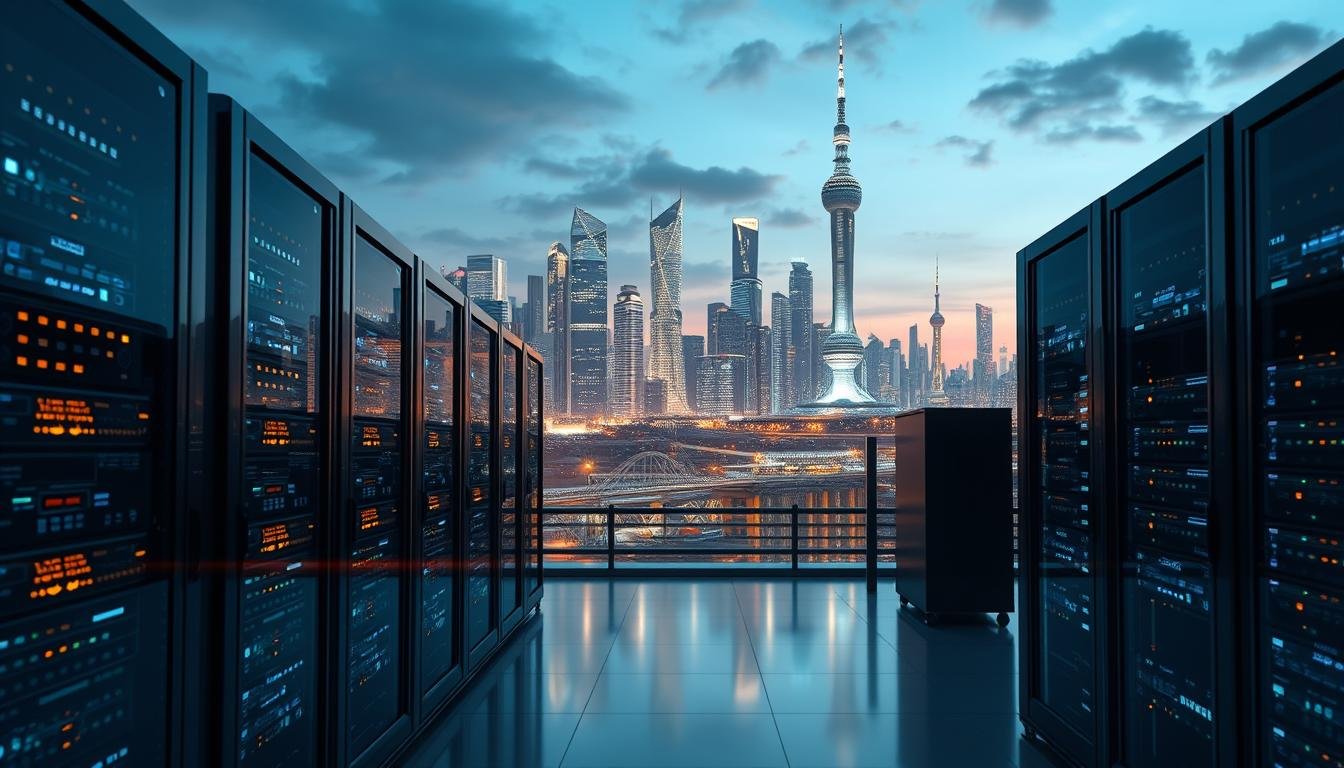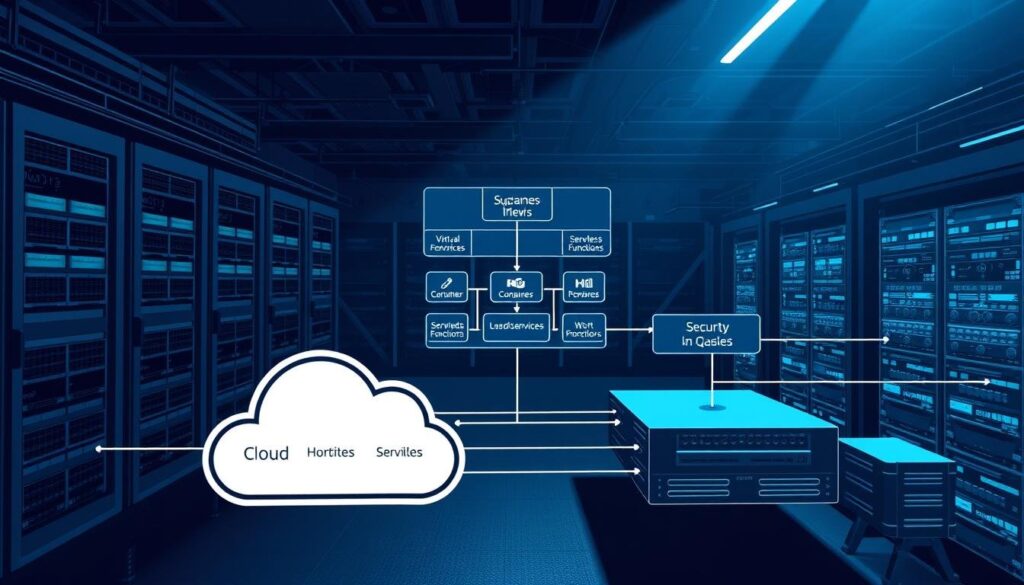What if your current approach to handling digital workloads is costing you time, money, and competitive advantage? As businesses generate data at unprecedented rates—from smart sensors to mobile apps—the traditional model of sending everything to centralized servers no longer works for everyone.

Modern organizations face a critical challenge: balancing instant responsiveness with massive scalability. Centralized systems excel at managing large-scale operations cost-effectively, while localized processing minimizes delays for time-sensitive tasks. The right mix depends on your unique operational needs.
We’ve seen companies transform their operations by strategically combining these approaches. A manufacturing plant might analyze equipment sensors locally to prevent downtime, while using centralized resources for long-term trend analysis. This hybrid model delivers both speed and depth.
Key Takeaways
- Modern data strategies require balancing centralized and localized processing
- IoT devices and real-time apps demand faster response times than traditional systems provide
- Latency-sensitive tasks benefit from immediate local analysis
- Scalable infrastructure remains crucial for large datasets and complex computations
- Hybrid approaches often deliver optimal performance and cost efficiency
- Industry-specific needs dictate the ideal balance between approaches
The explosion of smart technologies forces businesses to rethink their infrastructure. By understanding how different methods handle data, you can build solutions that grow with your needs while maintaining critical performance standards.
Introduction: Navigating the New Era of Data Processing
Organizations are redefining success by optimizing where and how they process critical information. Connected devices now generate data at speeds that strain traditional systems, demanding smarter strategies for balancing responsiveness and scalability. Immediate insights from IoT sensors or AI-driven tools require faster analysis than centralized models can deliver.

Recent studies show over 80% of enterprises prioritize centralized systems for long-term growth. Yet field operations often need localized solutions to meet strict latency thresholds. This tension creates opportunities for hybrid models that combine strengths:
“The future belongs to architectures that place resources where they matter most—whether that’s a remote oil rig analyzing drill data or a retail chain personalizing customer offers in milliseconds.”
AI applications highlight this shift. Autonomous vehicles, for example, can’t wait for distant servers to process collision warnings. Similarly, healthcare devices monitoring patients require instant feedback loops. These scenarios demand distributed frameworks that prioritize speed without sacrificing analytical depth.
We help businesses navigate these changes by focusing on three pillars: compliance with regional data laws, cost-effective bandwidth management, and workload-specific resource allocation. The goal isn’t choosing sides—it’s building systems that adapt as needs evolve.
The Fundamentals of Cloud Computing
Innovative IT strategies now prioritize flexibility and cost efficiency. Modern businesses leverage shared resources to streamline operations while maintaining growth potential. This approach eliminates the need for physical hardware investments, creating agile environments where organizations scale on demand.

Definition and Core Concepts
Gartner defines this model as “scalable IT-enabled capabilities delivered as a service via internet technologies.” Instead of maintaining local servers, companies access virtualized resources through third-party providers. These pooled assets include storage, databases, and analytics tools available through subscription models.
The system operates on three primary principles:
- On-demand self-service provisioning
- Broad network access through web interfaces
- Resource pooling across multiple clients
Key Benefits and Use Cases
Organizations gain immediate advantages through operational cost reductions. Pay-as-you-go pricing replaces large upfront investments, while automatic updates ensure cutting-edge security. Teams deploy applications faster by bypassing hardware procurement delays.
Proven applications include:
- Rapid software development environments
- Cross-region workforce collaboration platforms
- Disaster recovery systems with mirrored data backups
“Enterprises achieve 40% faster time-to-market using cloud-based development tools compared to traditional methods.”
By outsourcing infrastructure management, businesses focus resources on innovation rather than maintenance. This model particularly benefits industries requiring elastic scalability, from e-commerce platforms handling traffic spikes to healthcare systems managing patient records securely.
The Fundamentals of Edge Computing
Gartner predicts 40% of enterprises will implement advanced localized systems by 2024—up from just 5% five years prior. This shift responds to growing demands for instant analysis in fields like manufacturing automation and emergency response networks.
Understanding the Localized Processing Model
Localized systems analyze information where it originates—think factory sensors making safety decisions without waiting for remote servers. By handling tasks on-site, these frameworks cut data travel distances dramatically. A wind turbine monitoring vibrations, for example, can adjust blade angles immediately when sensors detect stress thresholds.
Three core benefits drive adoption:
- Millisecond responses: Critical operations like robotic surgery tools can’t tolerate delays
- Bandwidth conservation: Only essential insights transmit to central hubs
- Regional compliance: Sensitive data stays within geographic boundaries
Primary Advantages in Time-Sensitive Scenarios
Emergency response networks showcase these systems’ value. Firefighters using augmented reality helmets receive real-time air quality updates processed locally, enabling faster evacuation decisions. This contrasts with traditional models where analysis might occur hundreds of miles away.
| Factor | Localized Systems | Centralized Models |
|---|---|---|
| Latency | 5-20ms | 150-500ms |
| Data Transmission | 10-30% sent | 90-100% sent |
| Reliability | Works offline | Network-dependent |
| Use Cases | Autonomous vehicles | Historical analytics |
Retailers like Walmart use these frameworks to manage inventory robots that restock shelves based on localized camera analysis. As one tech leader noted: “Systems that decide before data leaves the room are rewriting operational playbooks.”
Understanding edge vs cloud computing Strategies
How do enterprises choose between instant action and deep analysis? The answer lies in matching technical capabilities to operational priorities. Localized systems thrive where milliseconds impact safety or revenue, while centralized models excel at handling massive datasets requiring complex computations.
Side-by-Side Comparison of Approaches
Consider a smart factory monitoring production lines. Local processing units make split-second adjustments to robotic arms, while historical quality patterns get analyzed remotely. This dual approach maximizes efficiency without compromising precision.
| Factor | Localized Processing | Centralized Systems |
|---|---|---|
| Response Time | Under 50ms | 200ms+ |
| Infrastructure | Distributed nodes | Consolidated servers |
| Data Handling | Filters & transmits 15% | Stores 100% |
| Best For | Traffic light systems | Sales trend forecasting |
Retail chains demonstrate this balance. In-store cameras using localized analysis track shelf inventory, triggering automatic restocking. Meanwhile, regional hubs aggregate sales figures to predict seasonal demand.
“Smart architectures don’t choose sides—they deploy resources where they deliver maximum impact.”
Key decision factors include:
- Urgency of operational decisions
- Geographic distribution of assets
- Bandwidth availability and costs
Energy companies exemplify this strategy. Offshore rigs process drill sensor readings locally to prevent equipment failures, while centralized platforms optimize global supply chains using decade-long production data.
Hybrid Cloud Architecture: Bridging the Divide
Modern enterprises are no longer confined to choosing between local and remote systems. By blending on-premises control with third-party scalability, hybrid frameworks create adaptive ecosystems. This strategy lets organizations secure sensitive operations while tapping into elastic resources for dynamic workloads.
Strategic Integration of Environments
Hybrid models follow a simple rule: “Centralize when possible, distribute when necessary.” A hospital network might process patient records locally for compliance, while using external platforms for AI-driven drug research. This balance maintains regulatory adherence without limiting innovation.
Three common implementation patterns demonstrate flexibility:
| Deployment Model | Use Case | Data Flow | Key Benefit |
|---|---|---|---|
| Cloud training → Edge deployment | Autonomous delivery drones | AI models update locally after central training | Real-time adaptability |
| Datacenter training → Cloud management | Financial fraud detection | Historical analysis informs live monitoring rules | Cost-efficient scaling |
| Edge training → Centralized models | Smart factory quality control | Machine vision insights aggregate for system-wide improvements | Continuous learning |
Retail chains exemplify this approach. Store servers analyze foot traffic patterns on-site for immediate layout adjustments, while regional hubs compare trends across locations. As one CTO noted: “Our hybrid infrastructure acts as both microscope and telescope—zooming into local details while maintaining big-picture clarity.”
These architectures reduce bandwidth strain by processing 60-80% of data locally. Only refined insights travel to centralized repositories, cutting transmission costs by up to 40%. The result? Faster decision cycles without sacrificing analytical depth.
Comparative Analysis: Latency, Bandwidth, and Costs
Operational efficiency often hinges on milliseconds and megabytes. Modern systems must balance rapid decision-making with sustainable infrastructure investments. Let’s examine how different architectures handle these critical factors.
Evaluating Processing Speed and Cost Implications
Response times separate mission-critical operations from analytical workflows. Localized analysis delivers results in 5-20ms—vital for manufacturing robots adjusting to sensor inputs. Centralized models often require 200ms+ for data roundtrips to distant servers.
Bandwidth consumption patterns reveal another key difference. Smart traffic systems using localized processing transmit only 15% of collected data, filtering out non-essential information. This contrasts with traditional models sending 90%+ raw feeds to remote facilities.
| Factor | Localized Systems | Centralized Models |
|---|---|---|
| Average Latency | 12ms | 275ms |
| Monthly Bandwidth | 150GB | 1.2TB |
| 5-Year Costs | $240k | $410k |
Cost structures show clear trade-offs. While localized infrastructure requires 35% higher initial investment, it reduces ongoing expenses through:
- 60% lower bandwidth bills
- 40% fewer network upgrades
- 30% reduced cloud storage needs
As one logistics manager noted: “Our hybrid approach cut transmission costs by 52% while maintaining real-time package tracking.” The optimal strategy positions time-sensitive tasks locally and reserves centralized resources for heavy computations.
Scalability and Flexibility: Cloud and Edge Facilities Compared
Business growth demands infrastructure that bends without breaking. Centralized platforms shine in elastic scaling, automatically adjusting resources during traffic surges or seasonal demands. A retail website handling Black Friday traffic, for instance, can ramp up server capacity in minutes—no hardware upgrades required.
Distributed systems take a different approach. Automated zero-touch provisioning lets factories deploy new sensors without manual setup. Each node operates independently, scaling horizontally across locations. However, individual devices prioritize responsiveness over raw power—a smart camera analyzes footage locally but can’t store years of video.
Flexibility separates these models. Centralized environments offer advanced analytics tools and global accessibility, perfect for multinational teams collaborating on AI training. Remote sites using localized processing maintain operations during internet outages, customizing workflows for specific machinery or regional regulations.
“True agility comes from matching resource allocation to operational urgency,” notes a tech director at a Fortune 500 manufacturer. “Our production lines use localized decision-making, while supply chain analytics run on scalable remote platforms.”
| Factor | Centralized Platforms | Distributed Systems |
|---|---|---|
| Scaling Speed | Instant provisioning | Location-by-location rollout |
| Resource Limits | Virtually unlimited | Device-specific constraints |
| Flexibility Focus | Service diversity | Offline functionality |
Smart organizations blend both approaches. A logistics company might process delivery routes locally in trucks while using centralized systems for fleet optimization. This balance ensures real-time adaptability without sacrificing long-term strategic capabilities.
Security and Compliance in Cloud and Edge Environments
Protecting digital assets requires more than firewalls—it demands location-aware strategies that address evolving threats. As regulations tighten globally, businesses must balance accessibility with ironclad protection across all infrastructure layers.
Navigating Legal Landscapes
Regional data laws like GDPR and CCPA create complex compliance puzzles. Systems storing information across borders face conflicting requirements—European customer records might need localized processing, while US healthcare data requires HIPAA-aligned safeguards.
We help clients implement geo-fencing protocols that automatically route sensitive information through approved jurisdictions. This approach reduces legal risks while maintaining operational fluidity.
Building Multi-Layered Defenses
Modern security frameworks combine encryption, behavioral analytics, and zero-trust principles. A manufacturing plant might use device-specific authentication for equipment sensors, while financial institutions employ AI-driven anomaly detection in transaction streams.
Key practices we recommend:
- Automated patch management for distributed nodes
- Role-based access controls with biometric verification
- Real-time threat intelligence sharing between systems
Retail chains using this model reduced breach incidents by 68% last year. As one CISO noted: “True protection means assuming every connection attempt is hostile until proven otherwise.”





